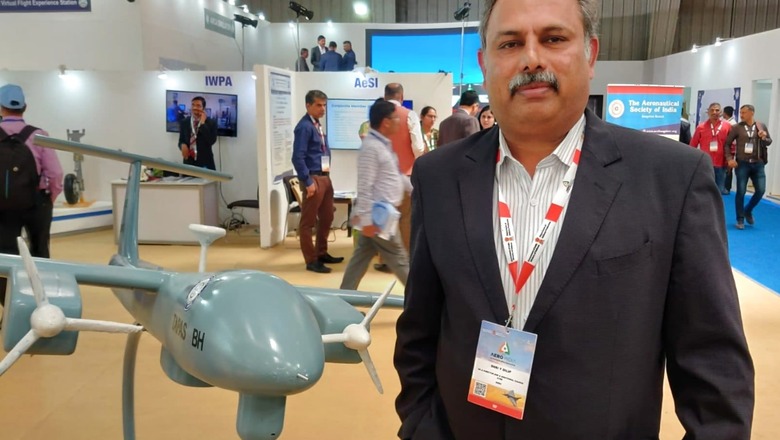
views
An indigenous engine of the light multirole fighter Tejas is on its way, Y Dilip, director of the Aeronautical Development Establishment (ADE) at DRDO, told News18 on Tuesday.
“I worked for Tejas for almost 25 years, before working on Tejas. Many systems in the Tejas avionics flight control, landing air system, airframe design, advanced avionics, general systems all indigenous substitutes are there. The indigenous drive is major in Tejas. Yes, the engine is the dependability right now,” he said at the Aero India 2023 in Bengaluru.
Y Dilip, who joined DRDO on September 13, 1991, started his career as a designer for the quadruplex flight control systems for the light combat aircraft (LCA) with core responsibility for the design and development of the digital flight control system architecture and computer (DFCC), which was flown successfully in 2001 and was type approved for LCA production requirements.
“I was also the director of GTRE (Gas Turbine Research Establishment) till a few weeks back. I must assure you that the development of the engine today is 73 kilonewtons as against 78 kilonewtons, which is the requirement with the Kaveri engine…it is all ready to go and efforts are on to fly the engine on the Tejas aircraft…very soon we will fly that,” he told News18.
Wealth of experience
Y Dilip worked in the field of real-time embedded system design and engineering of avionics systems for manned and unmanned aerial with core specialisation on highly reliable and redundant architecture systems for “Safety Critical Embedded Systems Designs”. In his 30 years of service at ADE, he has contributed to projects and programmes in various capacities, provided technical guidance and support for project teams of Rustom-I, Rustom-II, Nirbhay, Sudarshan, Nishant and L-II programmes. He led the team towards design, development, flightworthy certification of Air Data Computer (ADC), Lavcon Air Data Computer (LADC) for LCA Mk1, 2A, Mk-II and LCA Navy. As a senior member of the IFCS group, he resolved issues with regard to integration sites and aircraft of LCA. As chairman of QRT, he resolved and streamlined the production of LCA-FCS LRUs.
Elaborating on the indigenous engine issue, he said, “Second is the dry engine of Kaveri for the strategic programme of unmanned combat aerial vehicles…which isn’t required after burner has completed and matured to a very high level of technology. A lot of improvements have been done to the engine. We are going to Russia for high-altitude testing for the engine. For the fourth-generation engine, the country has full capability to produce the engine. The Kaveri engine expected to be ready by 2024 or 2025. All tech is ready. If sanctions and funding come, it can be done in record time.”
On TAPAS UAV
He also discussed the Tactical Airborne Platform for Aerial Surveillance-Beyond Horizon-201 or TAPAS BH-201 and its competition with the IAI Heron UAV.
“This is completely indigenous technology built for UAV in the category of Medium Altitude Long Endurance TAPAS UAV. Every system that goes with this bird is completely Indigenous…including the engine. This has been made by another DRDO laboratory along with a private player based in Coimbatore. The indigenous content is very important for self-reliant India, Atmanirbhar Bharat. This will also reduce the cost in the long run,” he said. “Avionics flight control, data link system, they are amazing in terms of technology and contemporary in nature. The system can take you to the line of sight and beyond the line of sight up to 1,000 kilometres. Data link has one important feature, that they are jam resistant. Everything has been done indigenously.”
He also spoke about the edge that TAPAS has over other UAVs. “Robustness, reliability of the bird, secure data links, autonomous technology for take-off and landing capabilities, and advanced ground control station which goes into flying this bird…Such features make it different and more capable than any other foreign make imported once. This advanced ground control station can be used to fly other UAVs that are going to be indigenous. You don’t have to own additional resources to fly those birds as well. The life cycle cost of this TAPAS will be reduced. Unlike other systems available in the market, especially the imported one (Heron UAV), it requires separate ground control system. Inventory maintenance, huge database, supply change management will become very difficult. At ADE we are looking for easy operability and maintainability in the long run. We are offering ground control system which is interoperable,” he said.
What defence minister says
Defence minister Rajnath Singh has said that the indigenous manufacturing of aero-engines is the need of the hour for the aerospace sector to achieve complete self-reliance, and the ministry is working on the details. He said that the LCA Tejas is a game changer for the aerospace industry.
According to the defence ministry, he emphasised on indigenous design and development of essential weapon systems using niche technologies like Artificial Intelligence. The ministry handed over the health usage and monitoring system for MIG29K developed through the Technology Development Fund to the Indian Navy.
Read all the Latest India News here




















Comments
0 comment